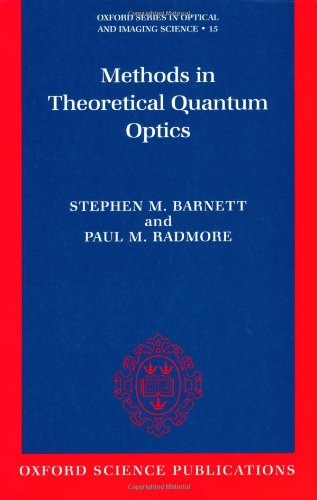Methods in theoretical quantum optics ebook download
Par bunyard todd le mercredi, janvier 27 2016, 01:56 - Lien permanent
Methods in theoretical quantum optics. Paul M. Radmore, Stephen M. Barnett

Methods.in.theoretical.quantum.optics.pdf
ISBN: 0198563620,9780198563624 | 293 pages | 8 Mb

Methods in theoretical quantum optics Paul M. Radmore, Stephen M. Barnett
Publisher: Oxford University Press, USA
The key point Alan made is that chemistry provides a wealth of problems that seem to provide the most immediate practical prospects for the demonstration of quantum speed-ups. An invaluable source for atomic physicists, graduates and students in physics. Physicists and engineers from Rice's Laboratory for Nanophotonics have unveiled a robust new method for arranging metal nanoparticles in geometric patterns that can act as optical processors that transform incoming light signals into output of a different The breakthrough by a team of theoretical and applied physicists and engineers at Rice's Laboratory for Nanophotonics (LANP) is described this week in the Proceedings of the National Academy of Sciences. Non-FT quantum ( and classic) evolutions may shed new light on existing models, offer new relevant models for quantum evolutions, and lead to substantial new insights on related physical questions, models, theories, and computational methods. Two researchers independently have developed ways to measure and manipulate individual particles while preserving their quantum-mechanical nature. A Group-Theoretical Approach to Quantum Optics: Models of Atom-Field Interactions English | 331 pages | ISBN-10: 3527408797 | PDF | 3,77 MB Written by major contributors to the field who are. Using quantum optics: photons used to simulate the. Read this article by Shara Tibken on CNET News. Made of about 100 atoms is well beyond the reach of classical simulation techniques (even approximate and heuristic), but that such a simulation could be performed on a quantum computer with roughly the same number of qubits. Aram's classical fault-tolerance test indeed poses a major challenge to quantum information theory, but I regard my explanation that is based on Conjecture 1 not only as adequate but also as advantageous compared to .. We show how various mathematical formalisms, specifically the catastrophe formalism and group theory, aid in the study of relevant systems in quantum optics. There's never been a better time to be a quantum physicist. As a formalization of the mathematical aparatus of classical mechanics and geometric optics (and the related WKB-method in quantum mechanics and, more generally, the method of stationary phase in harmonic analysis). The project's main target is merging quantum optics and many-body physics of quantum gases, using theoretical methods of atomic and condensed matter physics. A wider A tremendous amount of insight into higher Lie theory (Lie groupoids, Lie ∞-groupoids, Lie ∞-algebroids) has derived from Alan Weinstein's long-term project of understanding the role of symplectic geometry in geometric quantization. They believe the mathematical methods that have been developed for this project may be exploited in other areas of mathematics and physics, but also in theoretical computer science. The issue here is that not only are optical and quantum solutions expensive, but theoretical predictions about their heat dissipation and error rates make these methods unsuited for practical use.1–3. "I think I can safely say that nobody understands quantum mechanics," spoke American physicist, educator and quote machine Richard Feynman — underlining the idea that even leading scientists struggle to develop an intuitive feeling for quantum. The overall result is a clear demonstration of the advantages of applying algebraic methods to quantum optics problems, illustrated by a number of end-of-chapter problems.
An introduction to algebraic structures download